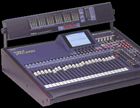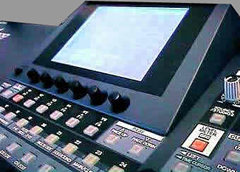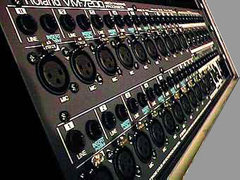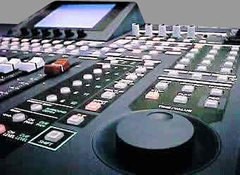 |
|
|
|
| |
|
|
|
|
|
DIGITAL
MULTITRACK
RECORDING |
|
MIDI
COMMUNICATION
|
| |
|

| |
 |
||
| |
||
 |
| INTRODUCTION | |
 |
With
VM-7000, Roland introduced a remote controlled digital mixing system,
currently unique in its price range, oriented to the middle area
of
the market. |
| MAIN PLUS | |
| Flexibility.
An open system based on the VM-7000 series components can be easily
tailored to any studio project need, allowing wide expansion possibilities
in comparison with the stand-alone mixing systems. |
|
 |
Logistics.
A remote controlled system offers big advantages when the instruments
and the audio units to connect are far away from it. A live concert is the typical situation where all instruments on stage are placed a hundred of meters away from the mixing console. The VM-7000 Mixing Processor can be placed on the stage providing a direct I/O access and avoiding the use of snakes (heavy, expensive and delicate multi-channel audio cables) that are currently used for the stand-alone consoles audio connection. Communication between VM Mixing console and VM Mixing Processor is assured by two standard AES/EBU digital audio cables. Only data concerned with the console operations is sent to the processor. No audio signals are exchanged between these two devices. In this way any possible hum-noise problem is eliminated. The VM Mixing Console can be confortably placed up to 200 mt. from the processor. The VM-7000 mixing system provides all the typical digital mixing advantages: scenes can be stored and configurations can be easily recalled. Moreover, additional features are available. For example a VM Mixing Console can remote control the inputs gain and the phantom power of the connected VM Mixing Processors on the stage, providing also a Virtual Patchbay function that allows a very flexible input-to-channel routing. High flexibility is also provided by the 12 FlexBus, that can be used as pre/post fader aux, effect send or, recording busses. |
| SIGNAL PROCESSING AND FUNCTIONS | |
 |
With
reference to the signal processing, the system comes from the long-experienced
Roland technology. Two on-board effect processors and a Master Out processor are available. Up to three optional boards can be installed, each one providing two stereo effects processors. In this case, a total of nine processors is available. They can be used simultaneously or independently as insert effects, assigned to a single channel or in send-return configuration. The most interesting algorithms provided by the system are RSS (that allows a sound source to be localized at specific points in a three-dimensional space, by using a conventional stereo system) and COSM, a Roland proprietary technology that allows to simulate the acoustic response of various transducers (i.e.: microphone types or guitar amplifier models). The same COSM technology provides the Speaker Modeling function, that allows to reproduce the sounds heard through different studio reference speakers, using the Roland digital DS90 powered monitors. Moreover, the system provides a built-in Realtime Spectrum Analyzer function that allows to measure the frequency content of audio signals without using any external device. The Smart Media technology has also been integrated, allowing a quick and safe storage of mixing data on a small card. |
| OPERATION AND CONCLUSIONS | |
 |
As
mentioned before, the VM Mixing Processor unit houses the system I/O.
It has been designed to be placed on the stage, remotely controlled
by the VM Mixing Console. In this way, the digital technology eliminates
the need of expensive multi-channel audio cables between stage and
mixer. On the other hand, it should be pointed out that external effects (i.e.: specific reverb, compressors, EQ, feedback suppressors, etc.) cannot be placed nearby the VM Mixing Console for programmming convenience, because the console is just a control surface. VM Mixing Console provides only a pair of audio inputs that are useful for talkback and secondary audio signals. The availability of built-in powerful effects should eliminate in most cases the need of external effects and seems to suggest the use of the VM-7000 as a fully-equipped system. Anyway, some users can consider this feature as a disadvantage. In this case, the only way to cover the gap is to use 2 VM Mixing Processors at the same time: one near the VM Mixing Console and one on the stage. Without any doubt, the system is powerful and flexible. Also, currently there is no way to buy something similar for such a price (other control surface-based systems cost much more). On the other hand, the VM system is not so intuitive and user friendly in terms of operation. The user interface also appears to be not really optimized for all those applications that requires fast access to channel parameters. Moreover, the not really fast response of motorized faders and screen refresh, in addition to the time required for the system startup (about a couple of minutes), can create some difficulties in certains circumstances. Fortunately some of these problems (i.e. fast control of channel parameters) can be solved by using the optional VE-7000 channel remote control that is strongly suggested to complete the control interface of the system. In conclusion: in order to take full advantage of the VM-7000 system applications and possibilities, the user should be prepared to spend some time to learn in detail the available functions, accepting the VM operating philosophy at the same time. |

